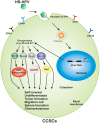Cervical cancer stem cell-associated genes: Prognostic implications in cervical cancer
- PMID: 31289465
- PMCID: PMC6540231
- DOI: 10.3892/ol.2019.10307
Cervical cancer stem cell-associated genes: Prognostic implications in cervical cancer
Abstract
Cervical cancer is the fourth most common type of gynecological malignancy to affect females, worldwide. Although high-risk human papillomavirus (HR-HPV) infection is the primary etiologic agent associated with the development of cervical cancer, cancer stem cells (CSCs) also serve a prominent role in the development, metastasis, recurrence and prognosis of the disease. CSCs are a small subpopulation of cells that have the ability to self-renew and are present in the majority of tumors, including cervical cancer. Studies describing the phenotype of cervical CSCs (CCSCs) vary in their definition of the expression pattern of principal biomarkers, including Musashi-1, aldehyde dehydrogenase 1, Oct3/4, Sox2 and CD49f. However, these markers are not observed in all cancers, although several may be present in multiple tumor types. The present review describes the potential biomarkers of CSCs in cervical cancer. These CCSC biomarkers may serve as molecular targets to enhance the efficacy and reduce the side effects associated with chemotherapeutic treatment in HR-HPV-positive cervical cancer.
Keywords: biomarkers; cervical cancer stem cells; high-risk human papillomavirus; transformation zone.
Figures


Similar articles
-
Cancer Stem Cells and Their Possible Implications in Cervical Cancer: A Short Review.Int J Mol Sci. 2022 May 5;23(9):5167. doi: 10.3390/ijms23095167. Int J Mol Sci. 2022. PMID: 35563557 Free PMC article. Review.
-
Role of Oct3/4 in Cervical Cancer Tumorigenesis.Front Oncol. 2020 Mar 11;10:247. doi: 10.3389/fonc.2020.00247. eCollection 2020. Front Oncol. 2020. PMID: 32219062 Free PMC article. Review.
-
Cancer stem cells (CSCs), cervical CSCs and targeted therapies.Oncotarget. 2017 May 23;8(21):35351-35367. doi: 10.18632/oncotarget.10169. Oncotarget. 2017. PMID: 27343550 Free PMC article. Review.
-
Transforming human papillomavirus infection and the esophageal transformation zone: prime time for total excision/ablative therapy?Dis Esophagus. 2019 Jul 1;32(7):doz008. doi: 10.1093/dote/doz008. Dis Esophagus. 2019. PMID: 31304554 Review.
-
Characterization of cervical cancer stem cell-like cells: phenotyping, stemness, and human papilloma virus co-receptor expression.Oncotarget. 2016 May 31;7(22):31943-54. doi: 10.18632/oncotarget.8218. Oncotarget. 2016. PMID: 27008711 Free PMC article.
Cited by
-
Combined delivery of salinomycin and docetaxel by dual-targeting gelatinase nanoparticles effectively inhibits cervical cancer cells and cancer stem cells.Drug Deliv. 2021 Dec;28(1):510-519. doi: 10.1080/10717544.2021.1886378. Drug Deliv. 2021. PMID: 33657950 Free PMC article.
-
Cellular Functions of OCT-3/4 Regulated by Ubiquitination in Proliferating Cells.Cancers (Basel). 2020 Mar 12;12(3):663. doi: 10.3390/cancers12030663. Cancers (Basel). 2020. PMID: 32178477 Free PMC article. Review.
-
Association of CD133, ALDH1, CD117 and OCT4 expression with prognosis of patients with cervical cancer.Virchows Arch. 2025 Apr;486(4):791-801. doi: 10.1007/s00428-024-03862-0. Epub 2024 Jul 9. Virchows Arch. 2025. PMID: 38981932
-
Advances in understanding the mechanisms of the human papillomavirus oncoproteins.Biochem Soc Trans. 2025 Jun 30;53(3):565-577. doi: 10.1042/BST20253041. Biochem Soc Trans. 2025. PMID: 40380881 Free PMC article. Review.
-
Prevalence of human papillomavirus detection in ovarian cancer: a meta-analysis.Eur J Clin Microbiol Infect Dis. 2021 Sep;40(9):1791-1802. doi: 10.1007/s10096-021-04282-7. Epub 2021 Jun 4. Eur J Clin Microbiol Infect Dis. 2021. PMID: 34086102 Free PMC article. Review.
References
-
- Globocan 2012, corp-author. http://globocan.iarc.fr. [Oct;2017 ];
-
- Badaracco G, Savarese A, Micheli A, Rizzo C, Paolini F, Carosi M, Cutillo G, Vizza E, Arcangeli G, Venuti A. Persistence of HPV after radio-chemotherapy in locally advanced cervical cancer. Oncol Rep. 2010;23:1093–1099. - PubMed
Publication types
LinkOut - more resources
Full Text Sources
